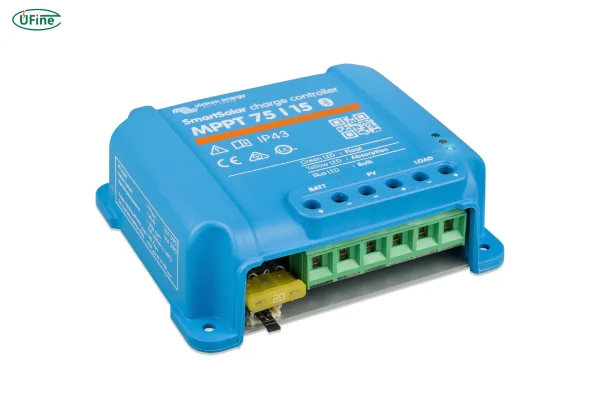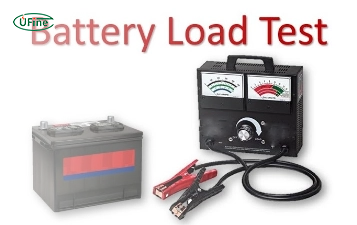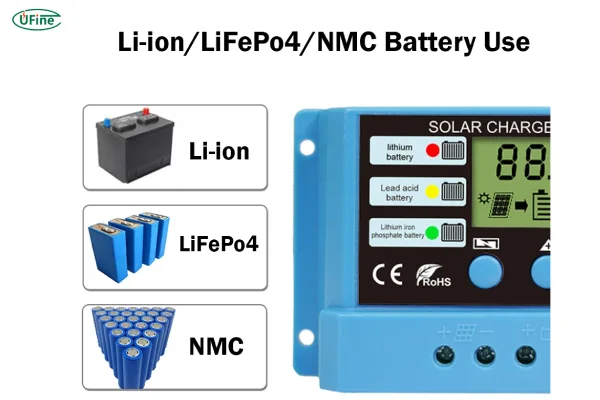
- Part 1. Why charge control is essential for lithium batteries
- Part 2. What is a charge controller, and how does it work?
- Part 3. Lithium battery charging profiles and chemistries
- Part 4. Why renewable energy systems require charge controllers
- Part 5. Charge controller vs. battery management system (BMS)
- Part 6. How to choose the right charge controller
- Part 7. When you may not need a separate charge controller
- Part 8. Mistakes to avoid when charging lithium batteries
- Part 9. Real-world use cases
- Part 10. FAQs
- Part 11. Final thoughts
Part 1. Why charge control is essential for lithium batteries
Lithium batteries offer exceptional energy density, long life cycles, and high efficiency. However, these benefits come at the cost of extremely tight voltage tolerances. A deviation of just 0.05V per cell during charging can lead to permanent degradation—or even catastrophic failure.
Unlike lead-acid batteries that can tolerate overcharging to some extent, lithium batteries must be charged with precision. Overcharging can cause electrolyte breakdown, thermal runaway, and fires. Deep discharging can lead to capacity loss and cell death. This is why controlling the charging process is absolutely critical.
A charge controller acts as a gatekeeper between the energy source (such as a solar panel, wind turbine, or generator) and your battery. It ensures that the battery is charged:
- Within the safe voltage and current limits
- With the correct charge profile
- While protecting it from environmental or load-based stressors
Part 2. What is a charge controller, and how does it work?

At its core, a lithium battery charge controller is a power regulation circuit that manages the flow of electricity into a battery. It continuously monitors battery parameters and controls the charge current and voltage accordingly.
Key components include:
- Microcontroller or analog control IC
- Voltage reference and comparators
- MOSFETs for switching or linear control
- Current sensors
- Thermal sensors
- DC-DC conversion stage (in MPPT models)
Functional Stages of Charging:
Bulk (Constant Current) Stage
The controller delivers maximum current until the battery approaches its target voltage (e.g., 4.2V/cell for Li-ion, 3.65V/cell for LiFePO4).
Absorption (Constant Voltage) Stage
The controller holds the voltage steady and allows the current to taper off naturally as the battery reaches full charge.
Cutoff
Charging is stopped to avoid floating—since lithium chemistries do not accept float charging like lead-acid does.
By managing these stages correctly, the controller preserves cycle life, avoids thermal issues, and maintains system reliability.
Part 3. Lithium battery charging profiles and chemistries
Different lithium battery chemistries have unique charge thresholds and thermal profiles. Misapplying charging parameters can drastically shorten battery life—or worse.
| Chemistry | Nominal Voltage | Max Charge Voltage | Notes |
|---|---|---|---|
| Li-ion (NMC, LCO) | 3.6–3.7V | 4.2V | Most energy dense, sensitive to overvoltage |
| LiFePO4 | 3.2V | 3.65V | Very stable and long-lived; popular for solar |
| LiPo | 3.7V | 4.2V | Light and compact; prone to swelling/fire if overcharged |
| LTO | 2.4V | 2.8V | Very fast charging, ultra-long cycle life |
A generic charge controller that doesn’t distinguish these chemistries is a liability. Lithium batteries are not tolerant of float voltage, and “universal” charge controllers often float at 13.8V–14.4V for 12V systems, which can overcharge LiFePO4 or Li-ion cells.
This is why choosing or programming a controller specifically for your battery type is essential.
How to Read Lithium Battery Discharge Curve and Charging Curve?
Part 4. Why renewable energy systems require charge controllers
In systems powered by renewables, energy input is neither constant nor predictable. Solar panels, for instance, can output voltage far beyond the needs of a 12V or 24V battery bank—often 18V to 50V depending on panel configuration.
This creates several problems:
- Unregulated high voltage can damage battery cells
- Inconsistent current can cause stress without tapering
- Sudden voltage spikes during peak sun hours can trigger overvoltage events
A lithium battery charge controller is essential to:
- Regulate input voltage and current to safe battery limits
- Match PV panel characteristics (especially with MPPT types)
- Prevent overcharging from prolonged peak sun exposure
- Cut off loads when the battery voltage drops too low
In solar systems, MPPT (Maximum Power Point Tracking) controllers extract maximum energy from PV panels while ensuring safe charging parameters for lithium cells.
Part 5. Charge controller vs. battery management system (BMS)
Many users ask: If my lithium battery has a built-in BMS, do I still need a charge controller?
The answer depends on your application:
| Feature | Charge Controller | BMS |
|---|---|---|
| Controls Input | Yes | No |
| Protects Cells | No | Yes |
| Performs Balancing | No | Yes |
| Manages Charging Source | Yes | No |
| System-Level Control | Yes | No |
The Charge Controller:
- Interfaces with external power sources
- Enforces charging profiles specific to battery type
- Handles load outputs, PV panel tracking, and source switching
The BMS:
Fast Charging Technology and BMS for Lithium Batteries/
- Sits inside the battery pack
- Manages cell balancing, short-circuit protection, and internal monitoring
In professional-grade systems, both are essential. The BMS ensures that each cell stays within safe boundaries, while the charge controller manages energy from unpredictable or intermittent sources like solar and wind.
Part 6. How to choose the right charge controller
A good charge controller for lithium batteries should meet both the electrical and chemical needs of your system. Here’s what to look for:
Key Selection Criteria:
1.Voltage Compatibility
Match to your battery system voltage (12V, 24V, 48V). For custom setups, make sure controller settings can be fine-tuned per cell group.
2. Amperage Rating
Controller should safely handle your max charge current. For LiFePO4 packs, use 0.5C–1C charge rates as a guideline.
3. Lithium-Specific Charging Modes
Many cheaper controllers are lead-acid oriented. Choose a model with programmable lithium modes or presets for LiFePO4, Li-ion, etc.
4. MPPT vs. PWM
MPPT controllers cost more but offer up to 30% more energy efficiency in solar applications by tracking the panel’s power curve.
5. Temperature Compensation
Some advanced lithium batteries allow limited charging below 0°C or above 45°C. Controllers should have thermal input sensors to avoid damage.
6. Load Control & Remote Monitoring
For remote systems, consider controllers with load output control, Bluetooth, or CANbus support.
Part 7. When you may not need a separate charge controller
In some plug-and-play systems, a charge controller may not be required:
- Power tool packs, e-bikes, and consumer electronics often have integrated smart charging systems.
- Wall chargers for lithium devices typically include circuitry that regulates charge.
However, in any renewable, off-grid, or DIY application, a charge controller remains indispensable.
Part 8. Mistakes to avoid when charging lithium batteries
Here are the most common—and dangerous—mistakes users make:
Using a lead-acid controller with lithium batteries
→ Risk of overcharging due to float voltage.
Charging at below-freezing temperatures
→ Lithium plating can occur, permanently damaging cells.
Setting incorrect voltage limits
→ Even 0.1V above spec can cause swelling or cell rupture.
Skipping pre-charge current limitation
→ Lithium batteries with very low SoC need gradual initial current.
Relying solely on the BMS
→ The BMS is your last line of defense—not a substitute for a controller.
Part 9. Real-world use cases
- RVs and Camper Vans: Solar + alternator charging requires a smart controller to switch sources and avoid overvoltage.
- Telecom Towers: Continuous uptime with lithium backup banks needs a robust charge controller for redundancy.
- DIY Home Powerwalls: Smart controllers balance battery charging with energy harvesting and inverter loads.
- Marine Systems: Charge controllers with waterproofing and thermal protection are crucial on water.
Part 10. FAQs
1. Can I use a lead-acid charge controller for lithium batteries?
No. Lead-acid controllers often apply float charging, which is harmful to lithium cells. Always use a lithium-compatible controller.
2. Is a BMS enough to protect my lithium battery?
Not entirely. A BMS protects individual cells but doesn’t manage the external power source. A charge controller complements it.
3. How does MPPT help in lithium battery charging?
MPPT tracks the solar panel’s optimal voltage/current and adjusts input to efficiently charge your lithium battery—especially important in changing weather.
4. What happens if I overcharge a lithium battery?
Overcharging causes lithium ions to deposit as metallic lithium, which can short circuit the cell and potentially lead to thermal runaway (fire or explosion).
5. Can I charge lithium batteries in freezing temperatures?
Most lithium chemistries should not be charged below 0°C. Specialized chargers or heating systems are required in cold climates.
6. What if my lithium battery already has a BMS and charger?
If you’re using the battery in a closed system (like a scooter or tool), you may not need an external controller. For open systems like solar setups, you still do.
Part 11. Final thoughts
So, do you need a charge controller for your lithium battery?
If you’re working with solar panels, wind turbines, or any unregulated power source, the answer is absolutely yes.
A lithium battery charge controller:
- Maximizes system efficiency
- Prevents dangerous overcharge/discharge events
- Works hand-in-hand with a BMS to protect your investment
- Enables safe and scalable energy storage
For peace of mind, especially in industrial or off-grid applications, consult experts like Ufine Battery, who can customize both the battery and its management system to your exact needs.
Related Tags:
More Articles

Battery Load Test: A Comprehensive Guide
Step-by-step battery load test guide for car, solar & industrial use. Learn how to load test a battery, interpret voltage charts, and avoid common mistakes.
The Comprehensive Guide to Battery Balancing and Battery Balancer
Discover how battery balancers improve lithium battery performance, lifespan, and safety. Learn types, functions, and tips to choose the right balancer.
What Is the Best Voltage for a Chainsaw Battery?
Compare 12V-80V chainsaw batteries for light pruning, medium firewood, and professional cutting. See best battery chainsaw with runtime charts and safety tips.
Lithium VS. Alkaline Batteries: A Comprehensive Comparison
Lithium batteries last 3–7× longer than alkaline and perform better in cold weather. Compare lifespan, cost, safety, and best uses to choose the right battery.
Comparing Lithium-Sulfur and Lithium-Ion Batteries: Which is Right for You?
Compare lithium-sulfur (Li-S) and lithium-ion batteries on energy, lifespan, cost, safety, and applications. Best choice for drones, EVs, and electronics.



